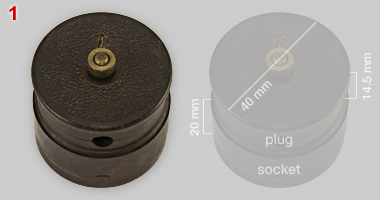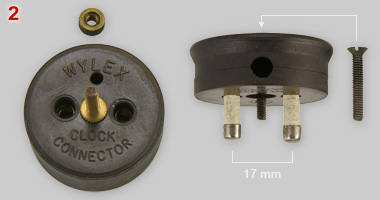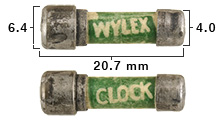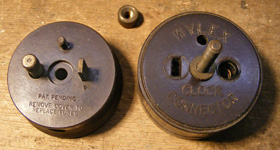 |
Wylex Clock Connector |
 |
Wylex Clock Connector |
| Wylex has also developed a special clock
connector. This 2-pole plug and socket is considerably smaller than the 13A, 5A and 2A
types for 'standard' domestic use, shown on the previous page. It is unknown when the clock connector has been produced. The specimen shown below was wired with lead sheathed cable, material that became obsolete at the end of the 1940s. The plug is fused, which became compulsory with the introduction of ring wiring in 1947. These two facts suggest that Wylex has designed clock connectors shortly after WW2. The Wylex clock connector was mounted in a pub in Little Easton, Essex, where it was noticed and rescued by Michael Milne. The museum is grateful to George and Rose Weston, landlords of the Stag, who agreed to donate this rare connector to the museum. |
 |
 |
||
 |
 |
| 1 | Wylex
clock connector consists of a Bakelite socket and plug. With screw and
nut, essential to keep plug and socket connected, the total height is
41 mm (1.61"). Diameter is 40 mm (1.57"). |
| 2 | Separate
views of socket (left) and plug (right). A 20 mm long screw keeps the
two parts of the plug together (see also no. 4). The screw protrudes
beyond the plug base and fits in an off-centre hole in the socket. This
feature prevents that the plug can be inserted in two positions. The
plug is therefore polarized, but L and N poles are not defined. The plug has two identical pins, both are fuses. Since plugs are polarized a single fuse is sufficiently safe, if L and N poles would have been clearly indicated. It is remarkable that a Wylex clock connector with a single fuse/pin existed also; see the image below the caption. The reason why a twin fuse clock plug has been made is not known. |
| 3 | Clock
socket in detail. Plug pins make contact with springs, rather than
slots. This unusual method requires that plug and socket are kept
firmly pressed together, hence the long brass screw visible in images
no. 1, 2 and 3. Plug and socket screwed together prevents an easy and
possible untimely disconnection; an advantage for clocks. The use of
fuses rather than solid metal pins could have been another reason for
using contact springs (see problems reported with fuse/pins in Dorman & Smith plugs). The underside of the socket base has the text: BCM / WYLEX. |
| 4 | Clock
plug in detail. Fuses are simply pushed in holes in the plug base. They
are fixed when top and bottom part of the plug are screwed together
(see no. 2). One fuse cap is larger than the other cap; see image no. 5
for details. The larrger cap makes contact with the copper strip in the
top half of the plug. Wylex fuse/pins differ from Dorman & Smith
fuse-pins |
| 5 |
 |
Wylex clock fuses have caps of unequal size: 4.0 mm and 6.4 mm respectively. Fuses act as plug pins and must be secured in the plug. Therefore the larger cap is positioned inside the plug. {DN} |
 |
Wylex clock connector with a fuse/pin (L) and a rectangular
brass pin (N). This type is not (yet?) in the museum collection. Image source: UK Vintage Radio Repair and Restoration Discussion Forum, section "Other Vintage Household Electrical or Electromechanical Items"; image posted by 'Tractorfan' (click link). |
| |
D i g i t a l M u s e u m o f | |
P l u g s a n d S o c k e t s | |